CPU of the Day: Fairchild F9445: The MicroFlame Flames Out
In the 1970’s many companies began to make processors based on mainframe architectures of the time. Data General with the creation of the mN601 MicroNova, TI with the TMS9900, DEC with the LSI-11 and others. This set the stage for a pretty large showdown, as what happens when a company other then the original mainframe company creates a processor that is compatible? This is what began to happen in the late 1970’s, and with the release of Fairchild F9440 MICROFLAME. We’ll quote directly from the F9440 datasheet “Though structurally different from the CPUs of the Data General NOVA line of minicomputers, the 9440 offers comparable performance and executes the same instruction set.” Specifically the bi-polar F9440 could
run most the code from the very popular Data General Nova 2 computer system. Obviously, as Fairchild states, it is structurally different, as its Fairchilds own hardware LSI implementation. The idea that an instruction set could be copyrighted was already being tested, and by all appearances at the time it was assumed that an Instruction set, could not be copyrighted. This certainly helped in the wide adoption late on of x86. A different way of protecting computer architectures had to be created then.
The first salvo was fired by Data General, in a lawsuit claiming that Fairchild’s F9440 enticed DG users to break their software license agreements. DG’s way of ensuring they had control of their customers was to add a section in the software license agreement that the software could ONLY be ran on Data General hardware, even if it COULD run on a Fairchild F9440 (or any other hardware) it was a violation of the license to do so. In 1978 Fairchild counter-sued, claiming that such a license was anti-competitive and seeking $10 Million in damages as a result of DG’s original suit.
To add fuel to the fire, Fairchild announced the F9445, the MICROFLAME II. The F9445 was built with the same I3L (Isoplanar Integrated Injection Logic) technology but on a 2-Micron process instead of the 3-Micron process of the 9440 and contained over 5000 gates. The F9445 could was compatible with the Nova 3 and Fairchild claimed it would be 10 times faster then the Nova 3. The F9445 was announced in 1978 but development issues (this was one of the largest, fastest bi-polar designs) took some time and led to many delays. In 1979 Fairchild, low on cash, was purchased by Schlumberger Limited, an oil field services company, for $425 million (Exxon responded by buying Zilog in 1980). Production of the F9445 finally began in the first half of 1981, with deliveries beginning late in the year. Initial devices ran at 16MHz (an increase from 12MHz in the original 9440) and 20 and 24MHz versions were released later. The F9445 required a single +5VDC supply and a 300mA current supply dissipating about 1.5W (compared to 1W for the 9440). The MICROFLAME II was aptly named, they ran rather hot (not unusual for their technology though). Like the F9440 the 9445 is a 16-bit processor and could directly address 128K of memory. It adds a stack pointer and hardware multiply, while retaining the same 50 instructions from the 9440 but increases the addressing modes supported from 8 to 11 (needed to emulate the Nova 3).
Interestingly the F9445 provided the base for another Fairchild processor. The F9445 took Nova instructions, decoded them and ran them on its hardware, it was, in other words, a micro-coded processor. Microcoded processors can be useful as the microcode can be changed to support an entirely different instruction set. That’s exactly what Fairchild did with the F9450, a processor designed to execute the just released MIL-STD-1750A 16-bit instruction set.
Data General was not pleased, so again sued, claiming that Fairchild probably stole proprietary information in order to design the F9445. Fairchild was not alone in the action as their were other companies who made Nova emulating hardware, as well as those who made software that would run on a Nova. The lawsuits (no less then 11 of them) continued well into the 1980’s. By 1986 Data General was struggling, the case continued, and was not going in their favor. In September of 1986, a month before the trial for damages was to begin, Data General settled, paying Fairchild $52.5 million. Eight years after the fireworks began, the original F9440 MICROFLAME had not been made in years, the Nova 2 and Nova 3 were no longer made as well. The lawsuits destined the F9440 and the F9445 to failure, but they made their mark in setting precedent in lock-in, and how Instruction Sets can be used.
In 1987 Schlumberger sold of Fairchild to National Semiconductor, who saw the F9445 as of limited use, and it was discontinued. Ironically this created a bit of a problem for many of the companies who made Nova emulators based on the F9445. Strobe Data was one of those companies. Strobe Data made a Nova PC add-in Emulator based on the F9445 called the Falcon. The end of production by National put them in a bit of a bind. There were really only two options, discontinue the Falcon line or find a replacement for the F9445.
Strobe at this time was developing the Hawk, another emulator that extended support to the DG Eclipse systems as well. It to would need to use the F9445 so a replacement was really the only option. Strobe turned to a nearby company called IC Designs (later acquired by Cypress) and jointly designed the ICD9445. The ICD9445 was a 1.25u CMOS implementation of the Fairchild F9445. Design work finished in 1990 and the ICD9445 was released with the Hawk emulator systems. The ICD9445 took advantage of newer technology (namely CMOS on a smaller process) which resulted in it being twice as fast as the original Fairchild part (and a lot cooler running). The Hawk emulators ended up being a very successful production (and continue to be available today).
Fairchild’s F9445 struggled due to the cloud of legal issues, and the changing ownership of Fairchild, but its legacy lives on. Today much of Data General Nova software continues to be ran on systems that DG tried to stop from ever happening. Data General itself no longer exists, being acquired in 2002 by EMC now part of Dell). And Fairchild? They were spun back off from National in 1997, and acquired by ON Semi in 2016.


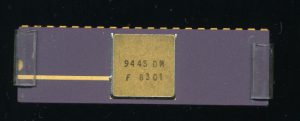
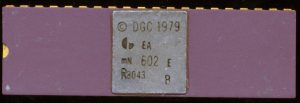
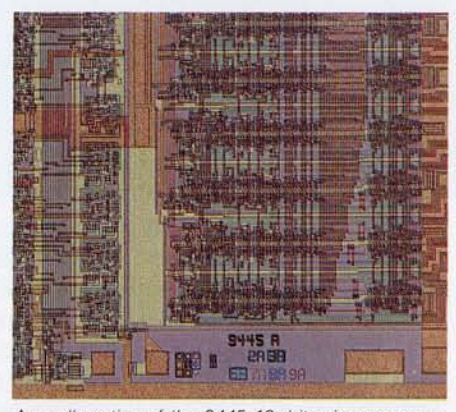
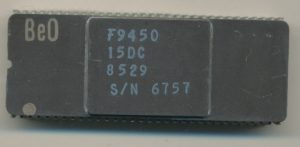
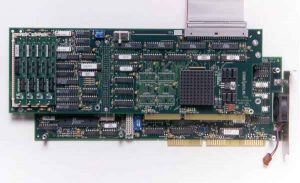
November 15th, 2017 at 4:08 am
At GM’s Delco Electronics we used quite a few of the Hawk emulators replacing the DG Nova 3’s on out LTX 77 linear test systems. It worked out nicely and some are still running today
November 16th, 2017 at 8:53 am
[…] CPU of the Day: Fairchild F9445: The MicroFlame Flames Out via […]
November 22nd, 2017 at 7:20 pm
Would love to get my hands on one, or at least a ICD9445
April 28th, 2018 at 11:41 am
This was a very interesting article, but reading it was like hearing fingernails on a chalkboard. YOU KEEP USING “THEN” INSTEAD OF “THAN”.
I’m surprised to see this error in such an otherwise well written article.
May 19th, 2018 at 7:29 pm
[…] processors lived as much as their title, working so sizzling that some chips were packaged on beryllium oxide, a poisonous ceramic that conducts heat higher than most metals. Sadly for I2L, CMOS became out to […]
June 12th, 2018 at 3:08 pm
[…] http://www.cpushack.com/2017/11/14/cpu-of-the-day-fairchild-f9445-the-microflame-flames-out/ […]
November 3rd, 2018 at 2:59 pm
Having worked on all three chip families, I would like to clarify a couple of points. The whole FIRE motif (Fairchild Interactive Real-time Executive) with the uFlame CPU, Firebug debugger, Spark SBC, etc. were associated with the 9440 chip only. There was never a uFlame II. The 9445 family branched out from the NOVA architecture, with the 9448 PIO designed to interface with both the Intel and Motorola buses at the time.
Unfortunately, in the words of one Fairchild executive: “microprocessors are a passing fad” and the company was reluctant to put the resources into the chips to make them successful.
An interesting note from the FSC/DG trials was that a certain company in Boca Raton had considered the 9445 CPU for their project.
The 9450 chip was created under a DoD contract for a radiation hardened CPU. Something the even today CMOS can’t do. Fairchild was more focused on their 32 bit Clipper chip, which is another museum piece.
I still have much of the old hardware if anyone wants images.
June 26th, 2019 at 1:54 pm
I cut my embedded software assembly language teeth writing 9445 code on a Nova II and downloading to a 9445 system to run and debug. I have fond memories of the instruction set, especially the skip “add-on” (SKP) to many of the instructions which allowed one to create some nice compact code (in my opinion). I miss those days!
Thanks for rekindling the memories. And Mark Markham, I’d enjoy any pictures you have to share.
January 25th, 2022 at 4:16 am
I have several for sale